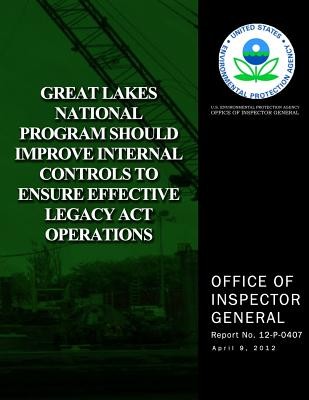
- We will send in 10–14 business days.
- Author: U S Environmental Protection Agency
- Publisher: CreateSpace Independent Publishing Platform
- Year: 2014
- Pages: 32
- ISBN-10: 1500562408
- ISBN-13: 9781500562403
- Format: 21.6 x 28 x 0.2 cm, softcover
- Language: English
- SAVE -10% with code: EXTRA
Great Lakes National Program Should Improve Internal Controls to Ensure Effective Legacy Act Operations (e-book) (used book) | bookbook.eu
Reviews
Description
Sediment contamination, primarily caused by industrialization in the Midwest, has been a problem in the Great Lakes for several decades. Historically, Great Lakes stakeholders have pursued sediment remediation through a variety of mechanisms, such as enforcement agreements and voluntary partnerships. It has been reported that polluted sediment is the largest major source of contaminants entering the food chain from Great Lakes rivers and harbors. This includes most of the areas of concern designated by the United States and Canada, the parties to the Great Lakes Water Quality Agreement. The Great Lakes Water Quality Agreement was first signed in 1972 and renewed in 1978. The agreement expresses the commitment of each country to restore and maintain the chemical, physical, and biological integrity of the Great Lakes Basin Ecosystem. EPA's Great Lakes National Program Office (GLNPO) was established in 1978 to oversee U.S. efforts to implement the Great Lakes Water Quality Agreement. Congress passed GLLA to expedite the remediation of contaminated sediment sites and improve the ability of the United States to meet its commitments under the Great Lakes Water Quality Agreement. GLLA established an innovative approach to conducting sediment remediation in that it uses partnerships with nonfederal sponsors to accomplish the work. Project agreements under these partnerships require that the nonfederal sponsor provide a minimum of 35 percent of the effort in cash or in-kind contributions to the project.
EXTRA 10 % discount with code: EXTRA
The promotion ends in 15d.21:14:56
The discount code is valid when purchasing from 10 €. Discounts do not stack.
- Author: U S Environmental Protection Agency
- Publisher: CreateSpace Independent Publishing Platform
- Year: 2014
- Pages: 32
- ISBN-10: 1500562408
- ISBN-13: 9781500562403
- Format: 21.6 x 28 x 0.2 cm, softcover
- Language: English English
Sediment contamination, primarily caused by industrialization in the Midwest, has been a problem in the Great Lakes for several decades. Historically, Great Lakes stakeholders have pursued sediment remediation through a variety of mechanisms, such as enforcement agreements and voluntary partnerships. It has been reported that polluted sediment is the largest major source of contaminants entering the food chain from Great Lakes rivers and harbors. This includes most of the areas of concern designated by the United States and Canada, the parties to the Great Lakes Water Quality Agreement. The Great Lakes Water Quality Agreement was first signed in 1972 and renewed in 1978. The agreement expresses the commitment of each country to restore and maintain the chemical, physical, and biological integrity of the Great Lakes Basin Ecosystem. EPA's Great Lakes National Program Office (GLNPO) was established in 1978 to oversee U.S. efforts to implement the Great Lakes Water Quality Agreement. Congress passed GLLA to expedite the remediation of contaminated sediment sites and improve the ability of the United States to meet its commitments under the Great Lakes Water Quality Agreement. GLLA established an innovative approach to conducting sediment remediation in that it uses partnerships with nonfederal sponsors to accomplish the work. Project agreements under these partnerships require that the nonfederal sponsor provide a minimum of 35 percent of the effort in cash or in-kind contributions to the project.


Reviews